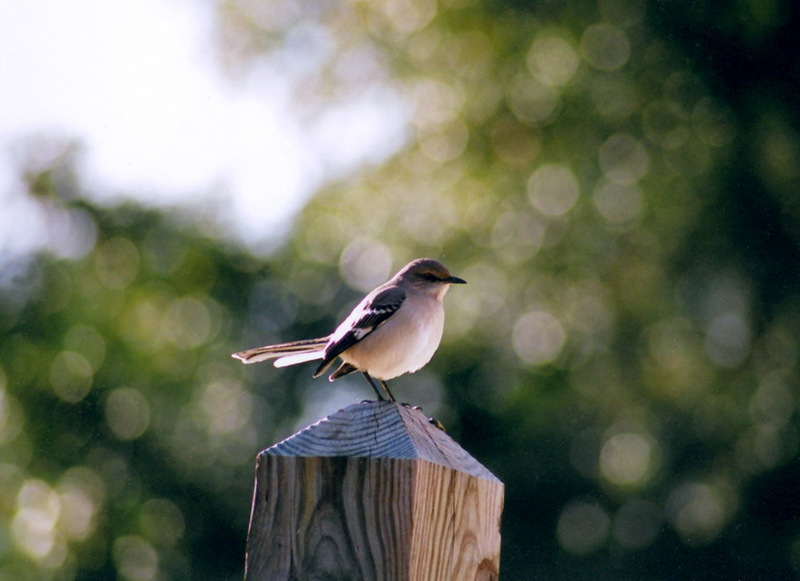Northern Mockingbird (Mimus polyglottos) - wiki Northern Mockingbird
From Wikipedia, the free encyclopedia
[Photo] Northern mockingbird on a wooden post. By http://en.wikipedia.org/wiki/User:Geogre
The Northern Mockingbird, Mimus polyglottos, is the only mockingbird commonly found in North America.
The Northern Mockingbird breeds in southeastern Canada, the United States, northern Mexico, the Bahamas, Cayman Islands and the Greater Antilles. It is replaced further south by its closest living relative, the Tropical Mockingbird Mimus gilvus. The endangered Socorro Mockingbird is, contrary to previous opinion, also closely related.
This bird is mainly a permanent resident, but northern birds may move south during harsh weather. This species has occurred in Europe as an extreme rarity.
Ecology
These birds forage on the ground or in vegetation; they also fly down from a perch to capture food. They mainly eat insects, berries and seeds. While foraging they frequently spread their wings in a peculiar two-step motion to display the white patches. There lacks consensus among ornithologists over whether this behavior is purely a territorial display, or whether the flashing white patches startles insects into giving up their cover.
The Northern Mockingbird builds a twig nest in a dense shrub or tree. It aggressively defends this nest and the surrounding area against other birds and animals, including humans. When a predator is persistent, Mockingbirds from neighboring territories, summoned by a distinct call, may join the attack. Other birds may gather to watch as the Mockingbirds harass the intruder.
Mockingbirds' willingness to nest near houses, loud and frequent songs, and territorial defense often annoy people. John van der Linden, author of the Eastern Birding Central FAQ, reports 25 to 50 percent of the e-mail questions he receives are concerned with how to deal with annoying mockingbirds.
Mockingbirds have a strong preference for certain trees such as maple, sweetgum, and sycamore. They generally avoid pine trees after the other trees have grown their leaves. Also, they have a particular preference for high places, such as the topmost branches of trees. Mockingbirds are often found in urban and suburban areas, where they perch on telephone poles, streetlights, or high points on buildings. While singing on a high perch they will often bolt several feet into the air in a looping motion, with wings outstretched to display their white underside, then land back on the perch without breaking a note. This action serves as a territorial display.
Song and calls
Although many species of bird imitate other birds, the Northern Mockingbird is the best known in North America for doing so. It not only imitates birds but also other animals and mechanical sounds such as car alarms. As convincing as these imitations are to humans, they often fail to convince other birds, such as the Florida Scrub-Jay.
The Northern Mockingbird's mimicry is likely to serve as a tool for increasing the size of its repertoire and thus its ability to attract females. The Mockingbird is limited to imitating short units of sound, which it repeats several times before moving on to a new sound. As a result, the Mockingbird sounds much better (to a human ear) imitating some species than others. Species with repetitive songs, such as the Carolina Wren are effectively copied, but species with long, complex songs, such as the Song Sparrow, cannot be effectively imitated by the Mockingbird.
The Northern Mockingbird, in addition to being a good mimic, is also one of the loudest and most constantly vocal of birds. It often sings through the night, especially unmated males, or when the moon is full. It sings year-round except sometimes for the late-summer moulting season. Individual males have repertoires of 50 to 200 songs; females sing as well, but more quietly and less often than males. Mockingbirds usually sing the loudest in the twilight of the early morning when the sun is on the horizon.
In addition to its well-known song, the Northern Mockingbird utilizes a variety of calls to communicate specific information. As with its song, these calls are among some of the louder sounds produced by birds of its size. Mockingbirds make a harsh, raspy noise when chasing other birds out of their territory. A similar but distinct call is used when defending against predators like a hawk or falcon. Other calls include a wheezing noise, a "chuck" note, and a very piercing series of notes "high low" repeated twice.
http://en.wikipedia.org/wiki/Northern_Mockingbird
| The text in this page is based on the copyrighted Wikipedia article shown in above URL. It is used under the GNU Free Documentation License. You may redistribute it, verbatim or modified, providing that you comply with the terms of the GFDL. |
